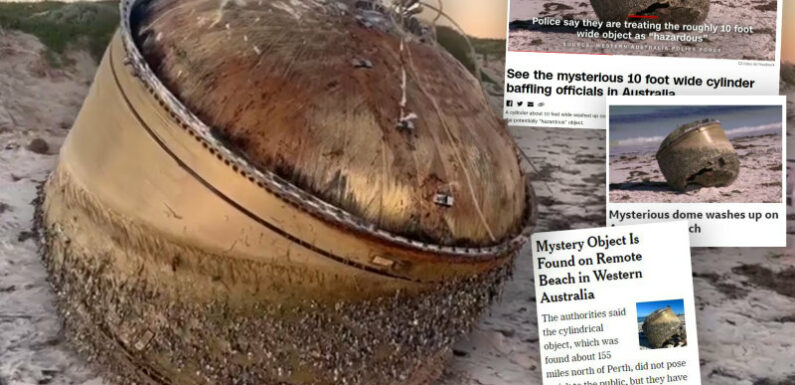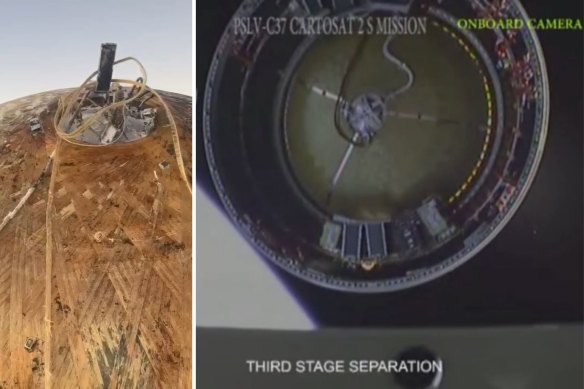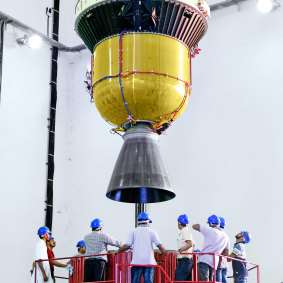
Save articles for later
Add articles to your saved list and come back to them any time.
The origins of a mystery object that washed up on a remote West Australian beach on Saturday has gained international attention as more experts join the chorus of people believing it is a piece of a rocket.
Green Head locals found the two-metre metal cylinder on Saturday, with local authorities cordoning the area off shortly afterwards and calling the military in to help identify it.
Within an hour of the first media report on the unusual find, Reddit posters had already come up with a theory the object was a piece of space junk from an Indian rocket.
Space experts agreed, with Australian National University astrophysicist Dr Doris Grosse and Flinders University space archaeologist Dr Alice Gorman believing it was likely a fuel cylinder from the third stage of a launch by India’s space agency.
The Australian Space Agency also commented the debris appeared to be from a foreign space launch vehicle.
The race to identify the object was covered by major international news outlets including the New York Times, BBC and CNN.
WA Police initially treated the object as hazardous, however late on Monday they advised it posed no risk to the public but would remain under guard while authorities investigate.
Police have not yet confirmed where the object has come from, but ruled out the possibility it was from a commercial aircraft.
However, Reddit sleuths were quick to pinpoint the cylinder’s likely origin to a specific model of Indian rocket regularly used to launch satellites.
The Polar Satellite Launch Vehicle has been used dozens of times over the past two decades to take a variety of satellites into low Earth orbit.
Reddit posters matched material fringing the “top” of the beached cylinder with similar features on the third stage of the PSLV rocket, along with points on the side of the tank where cables would have been attached.
Left: the top of the object found on a beach in WA’s Mid West. Right: onboard camera footage of state 3 of a PSLV rocket detaching during flight.
Onboard camera footage of the third stage detaching from a PSLV rocket also reveals features bearing a striking similarity to those found on the top of the tank washed up in WA.
Some posters even theorised the debris could have come from a specific mission – PSLV-CA C46 – which launched in May 2019 and dropped some debris in the ocean to Australia’s north-west and south-east.
The third stage of an Indian PSLV rocket. Credit: Indian Space Research Organisation
The amount of barnacles on the cylinder, an indication of the amount of time it had spent adrift in the ocean, meant a question mark still hung over the object’s exact origin.
If it was a piece of space junk, Australian National University astrophysicist Brad Tucker said it would have a serial or catalogue number on it to help identify its origins.
WA Premier Roger Cook on Tuesday flagged that the debris could become part of a local display.
“The consensus seems to be growing that it’s probably some returning space debris,” he said.
“Perhaps this would be an addition to the Skylab pieces that we have in the museum and might add to our growing collection of space debris which seems to be collecting in WA.”
Space debris – both man-made and natural – has a habit of coming down in WA’s vast outback, although it is rare for it to be found washed up on the state’s 12,895 kilometres of coastline.
Most famously, the Skylab space station came hurtling back to Earth in 1979, with pieces of the rogue station found in the most remote of outback locations in Balladonia, north-east of Esperance in WA’s south.
The local council hit NASA with a $400 littering fine, which reportedly remains unpaid.
But scientists with their eyes trained on the skies have also recovered fragments of space rocks which have made it through the atmosphere and slammed into the ground in WA’s outback.
The Desert Fireball Network, run out of Perth’s Curtin University, recovered a 1.15-kilogram meteorite from Morawa, in WA’s Wheatbelt, which fell to Earth on Halloween in 2016.
That brick-shaped fragment, however, is dwarfed by the Mundrabilla meteorite, a 12.4-tonne hunk of iron discovered in 1966 just west of the border with South Australia.
Get the day’s breaking news, entertainment ideas and a long read to enjoy. Sign up to receive our Evening Edition newsletter here.
Most Viewed in National
From our partners
Source: Read Full Article

